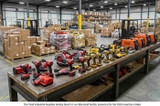Top Eight Energy-Saving Tips for Using LED Lighting in Your Home and Workspace
Top Eight Energy-Saving Tips for Using LED Lighting in Your Home and Workspace
In the ever-evolving lighting world, Light Emitting Diodes, known as LED lights, have emerged as a trailblazer. These tiny, semi-conductor devices convert electricity into light, offering outstanding energy efficiency compared to their traditional incandescent and fluorescent counterparts. With their innovative design and superior efficiency, LED lighting has revolutionized how we illuminate our spaces aesthetically and functionally. This article explores eight energy-saving tips for using LED lighting in your home or any commercial workplace.
In today's world, where energy consumption significantly impacts the environment and our wallets, conserving energy has become a priority for many. As we strive towards a more sustainable future, small changes like switching to LED lights can add to significant energy savings. LED lights use at least 75% less energy and last 25 times longer than traditional incandescent bulbs, making them a crucial player in our quest for energy conservation. They're a trend and a step towards a more energy-efficient future.
Main Takeaways of the Article: "Top Eight Energy-Saving Tips for Using LED Lighting in Your Home and Workspace"
| LED lighting offers superior energy efficiency and a longer lifespan compared to traditional bulbs. | Maximizing the use of natural light through sunlight and reflective surfaces reduces the need for artificial lighting. |
| Upgrading to LED lights in your home and workspace can lead to significant energy savings. | Automation features like sensors and timers automatically turn off lights in unoccupied rooms, enhancing energy efficiency. |
| Reflectors and directional lamps can optimize the efficiency of LED lights by focusing light where it's needed. | Dimmer switches allow you to control brightness, extending the lifespan of LED lights and saving energy. |
| Cultivating responsible lighting habits, such as turning off lights when not in use, contributes to energy conservation. | Proper placement of LED lights and regular maintenance help optimize their performance and reduce energy consumption. |
The Superiority of LED Lighting
The superiority of LED lighting over traditional methods becomes evident when considering two critical factors: energy usage and lifespan. Firstly, LED lights outperform their conventional counterparts in terms of energy efficiency. Where incandescent bulbs waste approximately 90% of their energy as heat, LEDs convert almost 95% of it directly into light. This efficient use of power leads to a marked decrease in electricity bills, making LED lighting an environmentally conscious choice and an economically savvy one.
Secondly, LED lights' lifespan trumps traditional incandescent and compact fluorescent bulbs. On average, LED lights have a lifespan of 25,000 to 50,000 hours, significantly higher than the 1,000 hours of incandescent bulbs and the 8,000 hours of compact fluorescents. This longevity results in fewer bulb replacements, further cost savings, and less waste production over time. As such, the initial investment in LED lighting is rapidly offset by the subsequent benefits, solidifying their place as the optimum choice for lighting in modern times.
Eight tips for using LED lighting
LED lighting in your home and workspace can contribute to substantial energy savings. Here are seven effective strategies to optimize their efficiency:
- Upgrade to LED Lights: Begin by replacing traditional bulbs with LED lighting. LED lights consume less energy and have a longer lifespan than their counterparts, making them a cost-effective choice in the long run.
- Install Reflectors and Directional Lamps: To enhance the efficiency of your LED lights, consider incorporating reflectors and directional lamps. By focusing light precisely where required, you can optimize illumination and potentially reduce energy usage by up to 50%.
- Practice Responsible Lighting Habits: Cultivate turning off lights when they aren't needed. This simple practice can contribute significantly to energy conservation.
- Maximize Usage of Natural Light: Harness the power of sunlight to illuminate your spaces during the day, thereby reducing dependence on artificial lighting and saving energy. Light-colored interiors and reflective surfaces can help disperse natural light more effectively.
- Automate with Sensors and Timers: Invest in modern technologies such as occupancy sensors or timers for your lighting. These tools can automatically switch off lights when a room is unoccupied, further enhancing energy efficiency.
- Implement Dimmer Switches: Dimmers are a fantastic addition to your LED setup, allowing you to control the brightness according to your needs. This extends the lifespan of your LED lights and contributes to energy savings.
- Ensure Proper Placement of LED Lights: Strategic positioning of your LED lights can optimize their performance and maximize energy savings. Direct your lights effectively to avoid wastage and enhance illumination.
- Maintain and Clean LED Lights Regularly: Lastly, consider regular maintenance's importance. Keeping your LED lights clean can significantly improve their light output and overall lifespan, thus reducing energy consumption in the long run.
Bringing Energy Efficiency into Your Home and Workspace
By conscientiously applying these energy-saving strategies, you can enhance the efficiency of LED lighting in your home and workspace. Start by replacing your conventional lights with LEDs, gradually integrating reflectors and directional lamps where necessary. Consider incorporating automation features like sensors and timers to cultivate mindful lighting habits. Implement dimmers to control brightness, and always aim for optimal light placement. Finally, maintenance and cleanliness are vital to the longevity of your LED lights.
These changes may seem small, but their cumulative impact on your energy consumption—and, consequently, your energy bills—can be significant. Professional guidance can make a substantial difference if you're uncertain about how to start.
Conclusion
LED lighting presents a simple and effective way to conserve energy in your home and workspace. By adhering to these seven tips, you can ensure you're leveraging the full potential of LED technology for energy conservation. Not only will this benefit your pocketbook, but it will also contribute to the larger goal of environmental sustainability.
As we conclude, we want to remind you of energy efficiency's invaluable role in our world today. LED lighting is more than an innovative technology—it's a step towards a more sustainable future.
Ready to transform your workspace with energy-efficient LED lighting? Contact us at Tend Industrial Supplies LLC for a quick quote and consultation. Please shoot us an email at sales@tendsupplies.com and start your journey to enhanced energy efficiency today.









